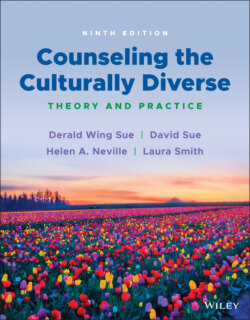Читать книгу Counseling the Culturally Diverse - Laura Smith L. - Страница 23
A WORD OF CAUTION
ОглавлениеThere is a word of caution that needs to be directed toward students of marginalized groups as they read CCD and find it affirming and validating. In teaching the course, we have often encountered students of color who become very contentious and highly outspoken toward White classmates. A good example is provided in the reaction of the African American student in the fourth scenario. It is clear that the student seems to take delight in seeing his White classmates “squirm” and be uncomfortable. In this respect, he may be taking out his own anger and frustration upon White classmates, and his concern has less to do with helping them understand than having them feel some of the pain and hurt he has felt over the years. It is important to express and understand one's anger (it can be healing), but becoming verbally abusive toward another is counterproductive to building rapport and mutual respect. As People of Color, for example, we must realize that our enemies are not White Americans, but White supremacy! Moreover, by extension, our enemy is not White Western society, but racism and ethnocentrism.
Second, because the book discusses multicultural issues, some students of color come to believe that multicultural training is only for White students; the implicit assumption is that they know the material already and are the experts on the subject. Since many students of color have not explored their beliefs about other groups, and sometimes their own, such a perspective prevents self‐exploration and constitutes a form of resistance. As will be seen in Chapter 8, People of Color, for example, are not immune from prejudice, bias, and discrimination. Further, such a belief prevents the exploration of interracial and interethnic misunderstandings and biases. Multicultural training is more than White–African American, White–Latinx American, White–Asian American, White–Native American, and so on. It is also about African American–Asian American, Asian American–Native American, and Latinx–Native American relationships; and it includes multiple combinations of other social identity differences, like gender, sexual orientation, disability, religious orientation, and so forth. Race, culture, ethnicity, gender, and sexual orientation/identity are about everyone; it is not just a “minority thing.”
